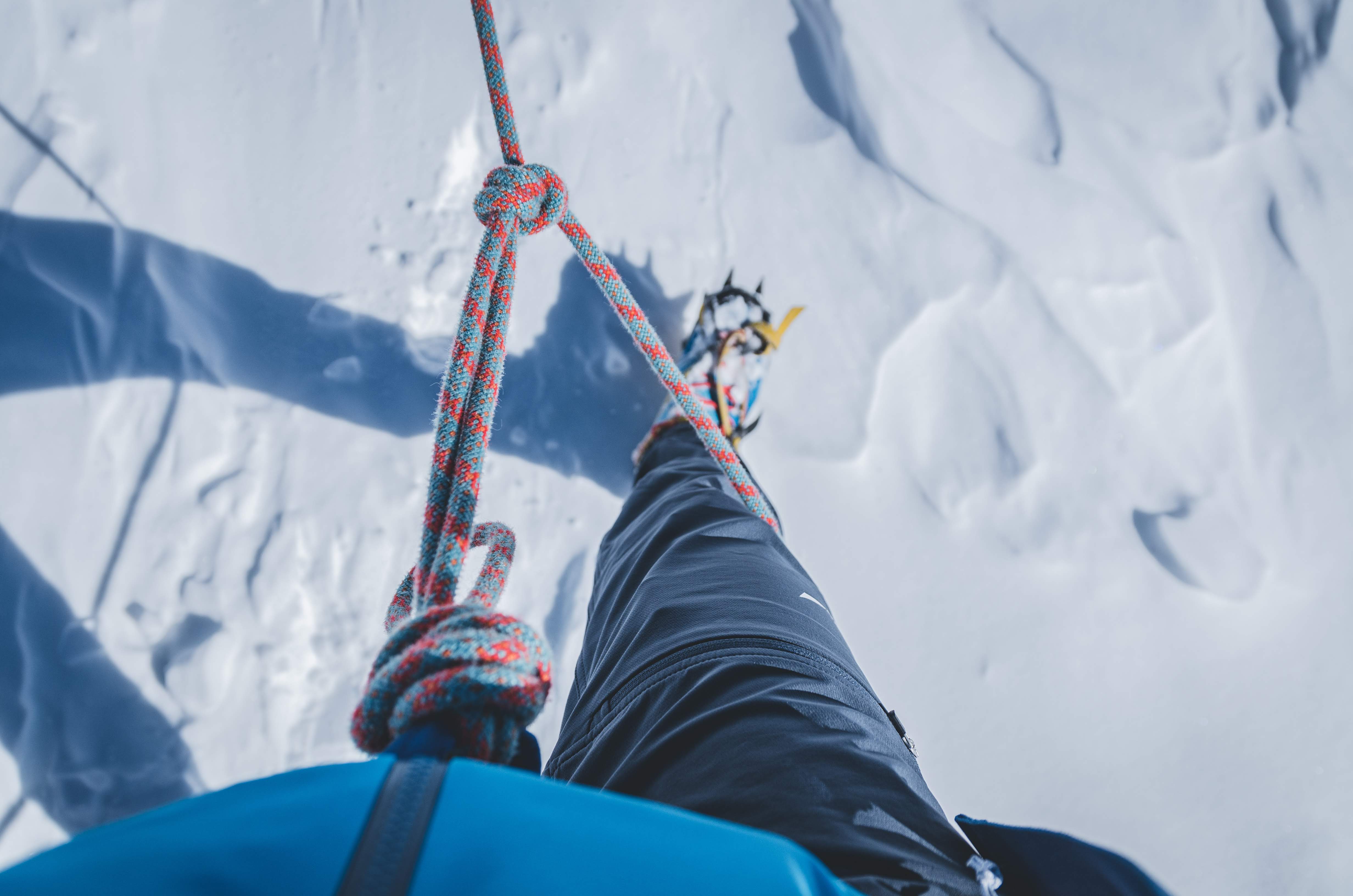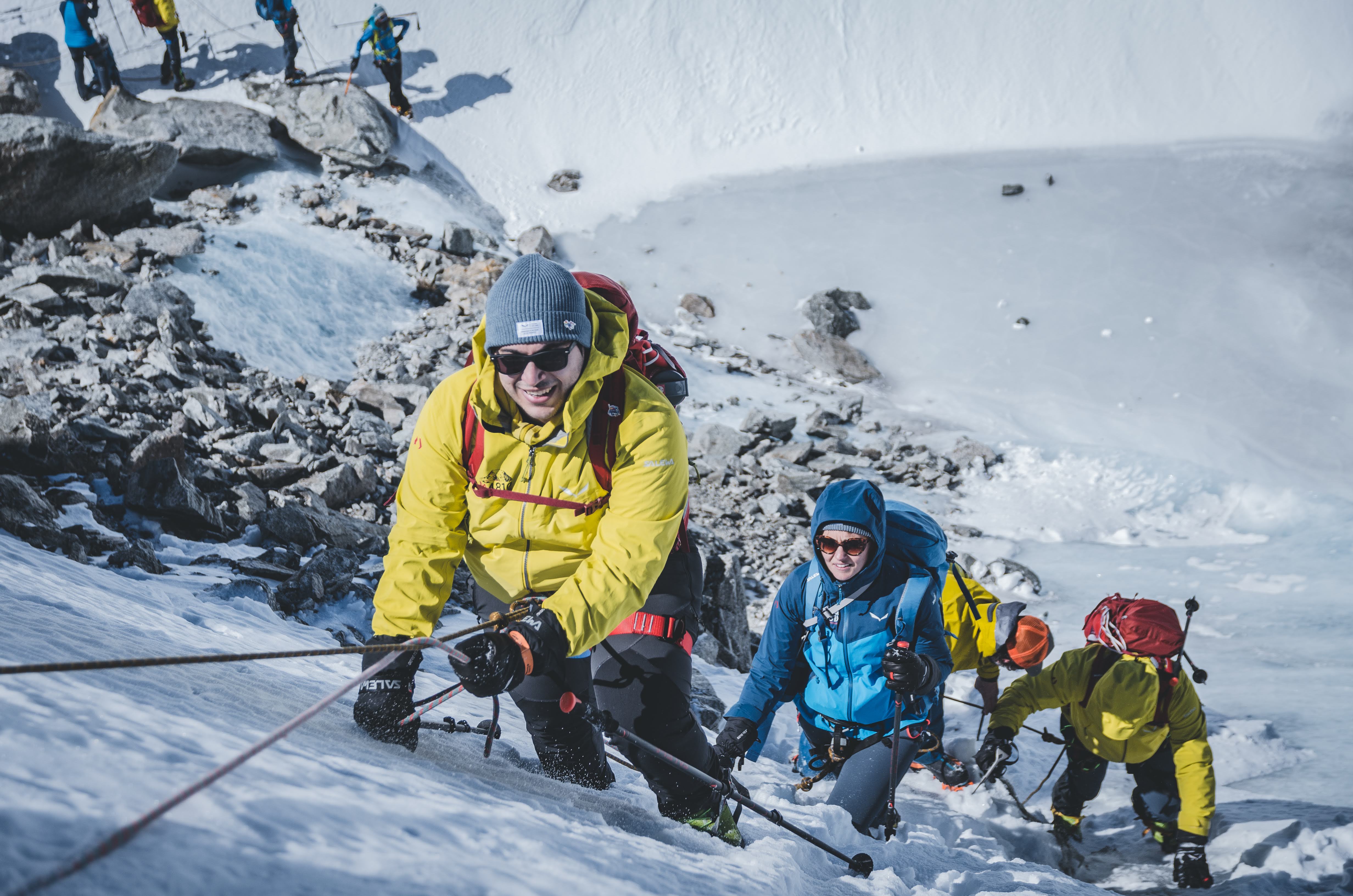
We’re all tucked into the cabin, on this Friday morning that seems much like any other. Some of us are leaning with our hands against the glass, some holding on to the handles hanging from the ceiling. But today, on this workday, we’re not in the Milan underground, nor are we heading to the Methodos offices. It’s not the dark underground tunnels that we see when we look out the window. We see something totally different.
Imposing white peaks surround us as we slowly get higher. We leave the spring weather behind and make our way to the kingdom of perennial snow and ice, towards the 3000 metres of our destination. 3462 metres above sea level. We’re on the Monte Bianco Skyway cable car, on our way to Pointe Helbronner. And we’re about to see something that will make us more deeply understand the meaning of our expedition.

There it is: in all its splendor, emerging above the other mountains with its twin white peaks. And for an instant, silence takes over.
It’s there, right in front of us – our final objective. The one we’ve been talking about for months, that we’ve been discussing and imagining, that has been attracting the attention and energy of this group of business consultants that are beginning to understand the measure of the challenge that awaits them.
It’s the first time that most of us are seeing it this close up in person. Or at least the first time since we set on this mission to reach its peak.
When I found out that the first training outing of 2019 would be a hike on the ice of the Pointe Helbronner, equipped with crampons, a shiver went down my spine.
It was something very different from everything that we had faced until that point. Snow and ice are a different world from the dirt roads and grass hills of the Val Massino, from the rugged crests of the Mont Fallère, and from everything else we had already faced. This would be our first outing with the crampons on the soles of our shoes. The first in which we would put on our Salewa Vultur boots and our winter technical gear. The first in which we would get an idea of the kind of situation that we would actually have to face when we try to reach the top of Europe… and as soon as in a couple of months, when we’ll cross the Vallée Blanche during the Red Week.

This experience presents another first for us: the altitude. Heads start spinning when we ascend from the 1200 metres of Courmayeur to the 3400 metres of this snowy peak that brings us to face the Monte Bianco. Legs start to go weak, stomachs start to turn, and walking starts getting difficult even for the fittest of us.
For some it’s just a slight feeling, for others a burden. Among the smiling, ecstatic faces that are contemplating the Monte Bianco, there are some that are paler than usual.
For some it’s not the first time: Daniele also felt sick years ago, when this same place held a Methodos convention. Today, his expression and concentration reveal the fight against his own personal demon: the fear of not being able to face the hike, of having to go back down.
We split into groups, with our harnesses already on and our crampons in our hands, and we head towards the snow and ice. My group of 7 powers towards the snow-covered glacier, connected by a long rope with our guide, Arnaud, in lead. We leave the rest behind and begin to fill our eyes with the splendor that surrounds us.
White and blue. Snow, ice, and sky. The only colours that we can see, studded only by our blue and yellow uniforms.

We’re directed towards the Col du Géante. While we walk we can see some brave mountaineers climbing towards the fascinating Dent du Géante… far away from us, and barely visible as they climb the rocky pillar. We follow our path, crossing this leg of the Mer de Glace, which makes us feel small.
Walking roped is a challenge. On one hand, it secures you, it ties you to the rest of the group and to its various paces. On the other hand, it pushes you to a new level of understanding: it erases differences, it unites to a single, collective effort towards a common goal.
Each person thinks about the one in front of them, drawing on the rope, regulating their pace, always careful not to get hammered or snagged by the razors that are the crampons.
It’s a new way of facing the mountains, one that makes us feel more united than ever. Ironically, it also unites us with the other groups, despite the distance.

But it also sets great challenges, as we find out in front of a wall of snow and ice as our guide looks at us, smiling.
“So, how do you feel about climbing up there?” he asks, pointing to it.
Perplexed looks follow his question. It’s not a path, it’s an almost vertical wall, shining under the March sun.
“But are you sure we can do it?” a skeptic participant asks.
There’s no real answer to this question, though. We need to try it to find out.
And so, we take on our first climb with crampons. Arnaud starts, kicking the snow with every step to get a good grip, and slowly – one by one – we follow. Our destiny is linked with the companions we’ve got in front of us and behind us – in their ability to avoid slipping down.

We got halfway up the wall when the layer of snow that was holding us up wears away, giving way to hard, slippery ice. In that moment, panic sunk in.
There were two people in front of me. When Andrea didn’t get a good grip onto the ice, he fell onto Tommaso, who in turn, slipped onto me. I let go with my hands just in time, avoiding getting cut by his crampon blades. His feet took the place that my fingers occupied just a few seconds earlier.
Andrea tried to get back up, kicking and pushing, but the ice was unforgiving.
Those seconds felt like hours while the companions further up tried to help and hold up the ones under, and we, below, tried not to slip.
Finally, a crampon caught on to the ice with a crack, and the tragicomic slip came to an end.
We began to climb again, this time more cautious and concentrated, and after few steps – that seemed to take forever – my hands grasped the top of the wall.
We did it!
My heart was beating out of my chest, and smiles were spreading across all the faces around me while we stepped into a group hug, walking sticks and rope surrounding us.
Another lesson learned – about the mountains and about team work. With crampons on, tied to a single rope, it’s essential to move in synch.
We have to move cautiously, a step at a time, careful to follow the person before us. It’s a slow process, where the first to climb does it not just for themselves, but for the team, and those who follow have to do the same.
One at a time, the other expedition groups get to the wall and face the challenge. From the top, we cheer them on and help in whatever way we can.
We have to face our fears even before facing the ice on these few meters of a climb. And we all, as we arrive to the top, smile like never before.
It’s what happens when we jump the hurdle that is our fear, when we face change and look back on the difficulties that it allowed us to overcome.
It’s what is happening to us on this expedition, outing after outing, step by step. Each step up brings us a bit closer to the Mont Blanc, but also closer to the heart of the change process that we’re facing. It’s what we did today, in the shadow of the mountain that has taken over our imaginations, and that pushes us to go further.
I can read it in their smiles, in their gazes. For the first time, even the most skeptical have a sparkle in their eyes. It’s the power of thinking, “We can actually do it!”
And when my eyes meet Daniele’s, tired but proud, I smile.
He faced the trek overcoming the fear of defeat that he brought with him from the last time, that conditioned him from the moment he stepped onto the cable car. I watch him rejoice, and feel joy take over me as well.
So, yes. We can, actually, do it.





